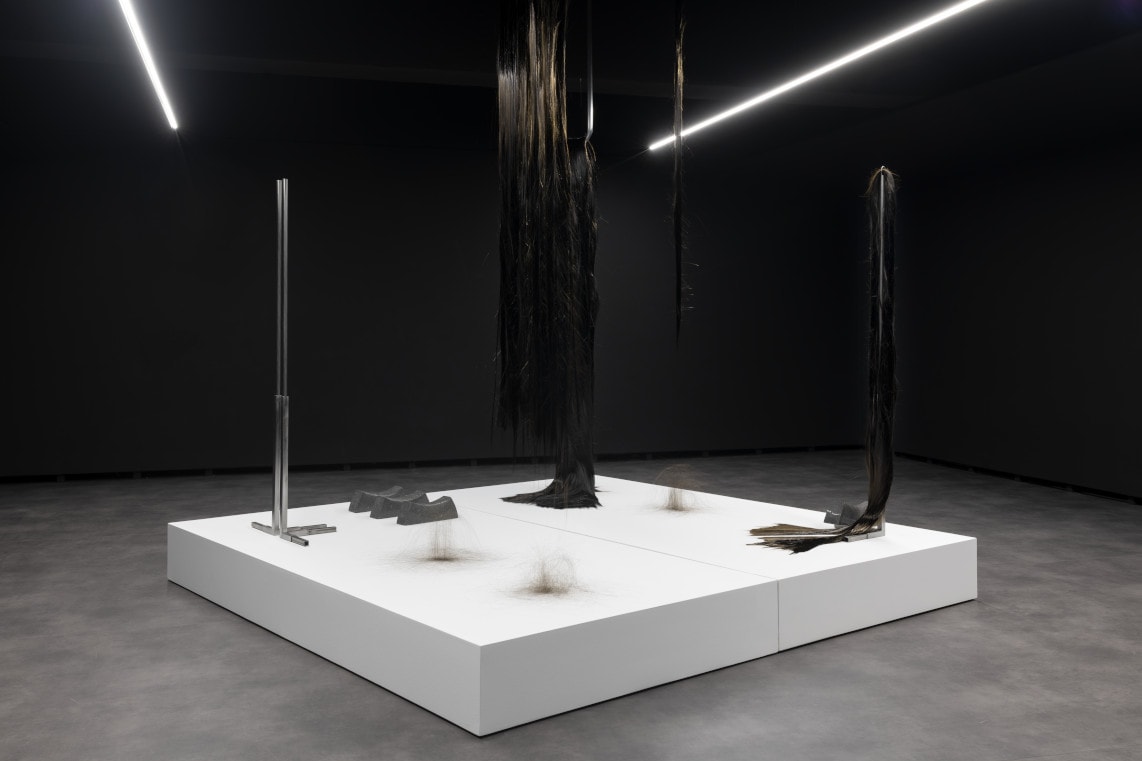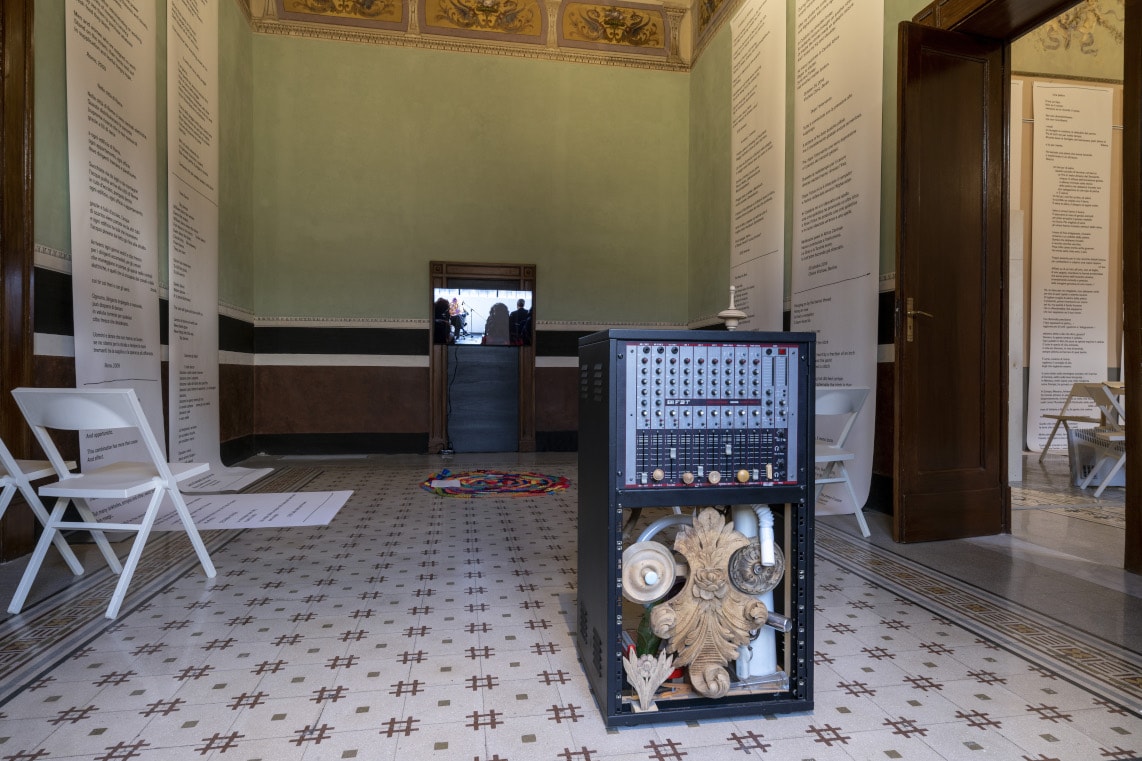Since December 2022 a powerful tandem of a large-scale retrospective of over 150 works by Jimmie Durham and another small but evocative portrait of the artist’s working processes have been presented in Napoli (his adopted home, alongside Berlin), paying homage to this important figure of the twentieth century born 1940 in the USA, and who passed away at the end of 2021 in Berlin.
Jimmie Durham: Humanity is not a Completed Project, at the Madre Museum curated by Kathryn Weir (23.12.2022 — 08.05.2023) and And now, so far in the future, That no one will recognize, Any of my jokes, at the private Fondazione Morra Greco, curated by Salvatore Lacagnina (22.12.2022- 31.07.2023), each offer profound and proximate encounters with the artist and his universes of thought, intervention and agency.
Jimmie Durham was a versatile and plural figure, who subverted stereotypes and the canonisation of artforms in his ingenuous, multilayered work, in which poetry, visual culture, singing, gave free expression to his autonomous world view. He exhibited worldwide, while in 2019, he was awarded the Golden Lion for Lifetime Achievement at the 58th Venice Biennale.
Political and ecological activism were fundamental in his life. Between 1973-1980 he was involved as a political organizer with the American Indian Movement, an umbrella group for organisations in Ecuador, Chile, and various North American indigenous groups. He worked at the U.N. as consultant and chief representative of the International Indian Treaty Council.
At Fondazione Morra Greco, you are given a sense of the person within the work, of his intimate universe – with Jimmie Durham’s personal books, photos, carpets, a stuffed lizard, installations, drawings originating from his atelier in Napoli – an immersive ‘study cabinet’ for shared knowledge and conviviality. The exhibition includes also videos with the artist reciting poetry, interviews, a film from his personal collection to be watched in a “home cinema”[1]. Emerging from a rich history of collaborations with the Foundation, this approximation to the artist’s personal universe is further emphasized by the enveloping presence of his poems printed on large scale banners coating the walls of the exhibition rooms, which speak out the fundamental concerns and themes in Jimmie Durham’s work.
Throughout his work, Durham de-conspired the current and historical effects of colonial and capitalist expansion, revealed racist agendas, the cultural and economic subordination of “minorities”, the ambiguity of cultural policy. One of his poems at Fondazione Morra Greco reads:
“In school I learned about the heroic discoveries
Made by heroes and crooks. The courage
of million of sweet and true people
Was not commemorated.
Let us declare a holiday,
For ourselves, and make a parade that begins
With Columbus victims and continues
Even to our grandchildren who will be named
In their honour.”
At the Madre Museum (Museo d’arte contemporanea Donnaregina), we are confronted with a substantial retrospective – Jimmie Durham: Humanity is not a Completed Project. The show is structured in a circular expositive parcour and explores extensively the lines of thought and activism in Durham´s work with a plurality of works, documentation and interpretation. This in depth research-based show is the result of the curator’s Kathryn Weir (also artistic director of the Madre museum) expertise on the artist’s work: analytical texts accompany every section of the exhibition and the individual works[2] and constitute a significant theoretical framing, which is fundamental for the reception of the multiplicity and liberty of Jimmie Durham’s thinking and creative expression.
Durham stated: “My work is based on the idea of science as curiousness, as a new way of seeing things, inquiry without preconception which leads to change and innovation. That is what science means to me: a lack of predefined ideas, an acceptance of discovery, an unexpected vision of reality.”
The show sets the accent on the artist’s important voice in rethinking the perpetuation of reductive constructions of identity, especially through their visual representation in the European canon. He worked with the historic museologic display model, which he appropriated and deconstructed with humour, but revealing the devastation associated to European imperialist expansion and hegemony, for which museology had been a significant tool. He revealed how the interest of the capital have manipulated the identity constructions of American Indian ‘minority’, subordinating and de-possessing them of land and ancestry.
The show features early works like On loan from the Museum of the American Indian (1985), Pocahontas’ Underwear, (1985) that parody the presumed authenticity of visual symbols politically staged to reinforce artificially defined identities, nations, ethnic groups and their belongings. The Indian Family (Frontal View) stages the artist in an Indian genealogy through found photography. A more recent work, The History of Europe (2012) presents Europe as a geo-political fiction, that reveals the incoherences of historic transmission of information.
Manifold collaborations and common work authorship have been developed with his life-long partner, the Brazilian artist Maria Thereza Alves. Among these, Museum of European Normality (2008) included in the Madre show, throws an inverted “ethnologic gaze” on Europe and on “European identity.”
Including a varied typology of works, the exhibition explores the vivid and flexible fronters between anthropomorphic, animal and ritual beings in Durham’s work, but is also populated by words (drawn, sang, hand written, spoken), decontextualised and then re-signified by the artist in his multi-layered work.
Architecture is also problematised in the Madre show: built structures, historically associated to domination are de-monumentalised – arches, tubes, the gargouille, support beams are turned into interchangeable, versatile means to de-materialise architecture and with it, its oppressive and conditioning heritage. In this context, Durham introduced the notion of Architexture (1994). The term could evoke Jacques Derrida’s Archi-ecriture, considering the deconstruction of the Western logocentrism and its authoritative origin for the diversification of identities (Jacques Derrida, Signature Event Context, 1972).
This life-encompassing exhibition in Madre is brought to an end (and with it we meditate on the artist’s recent departure) with a metaphysical actualisation of his presence, through a series of symbolic works: the unpublished poem Now written by Jimmie Durham in response to a request from Kathryn Weir in Napoli in 2020 the stone installation dematerialised as A Cloud and a sort of permeable museum – a primary school desk with a box in which the visitor can throw his relics and thoughts[3].
[1]Perry Henzel (director), The Harder They Come, 1972, 106′.
[2] A full room-by-room exhibition visit is accessible online at www.madrenapoli.it/en/exhibition/jimmie-durham-humanity-is-not-a-completed-project/)
[3]Módulo Gallery in Lisbon hosted (1995) Jimmie Durham’s first solo exhibition in Portugal titled Brief History of Portugal. In 2019/2020, Delfim Sardo curated a second solo show in Culturgeste Porto, ‘Do you say that I am lying’ ?, conceived around José Saramago’s book ‘The Year of the Death of Ricardo Reis‘ (considered by the artist a significant reference) including typed or handwritten quotes from the book, integrated by the artist into each piece.

